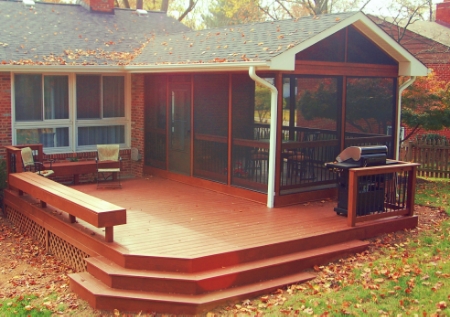
The Professional Approach to Installing a Porch Screen
Not too long ago, there was only one method of installing a screen for a screened-in porch. This old-fashioned method was a cumbersome process which involved attaching screens to porch railings and posts using small tacks, staples, or nails. These fasteners were then covered by wooden lattice strips that served as trim. Nowadays, manufacturers have conceived better screen installation methods that are longer lasting and on the radar of up-to-date screen porch contractors.
Be Wary of the Old
The dated way of screening in a porch had two major flaws. Firstly, screens installed in this method have a tendency to become loose and sag. Secondly, these screening systems are difficult to replace or repair, since the process involved removing the lattice and pulling out all the individual tacks or staples. After reattaching a new screen again with new fasteners, a builder would have to install new pieces of wooden lattice, which would oftentimes look different and clash with the existing lattices. The lattice and screens were typically installed on the exterior of a porch, which required the use of a ladder for elevated porches. Having this screening system in place was costly for homeowners, since it involved lengthy, labor-intensive installation and frequent, equally arduous maintenance.
The New Method
If you are a homeowner who is thinking of screening in your porch, you’ll be happy to know that there are much more efficient, effective, and economical screening systems on the market today. Typically, these systems eschew nails, tacks, and staples in favor of a simple snap-on cap system. Snap screen systems are quick and economical to install, and equally quick and economical to remove and replace. Most importantly, modern screening systems look clean and attractive, and are not prone to sagging.
SCREENEZE is one of the more popular of these newer systems. It features a vinyl cap and aluminum base that are snapped together to hold screens tightly tensioned, making them easy to replace should they ever become damaged.
A Step-By-Step Guide to the SCREENEZE Installation Process
Step One: Gather Parts and Tools
Your contractor will collect the necessary SCREENEZE components, including the aluminum base, vinyl cap, screws, and recommended screens. Next, the contractor will gather the tools required for installation, including a rubber mallet, flat screwdriver, utility knife, screw gun, hacksaw, tape measure, and ten-inch miter saw.
Step Two: Determining the Type of Application
A contractor will need to determine the type of application and framing requirements. This will be different depending on whether the project calls for a corner mount exterior detail, corner mount interior detail, flush mount exterior detail, or flush mount interior detail. Framing options include traditional, screening flexibility, and bringing the outdoors in.
Step Three: Cutting and Snapping
Next, your contractor will snap the vinyl cap onto the aluminum base, before measuring the opening and cutting as necessary.
Step Four: Installing Screws
A contractor will determine and mark screw locations, before placing cut pieces in the opening and checking for a fit. Then, your contractor will attach the aluminum base to the frame of your porch with screws.
Step 5: Installing the Screen
Finally, the contractor will snap the screen in place between the vinyl cap and aluminum base using the rubber mallet. Afterward, he or she will use a razor knife to cut away excess screen.
In the hands of a capable contractor, the process should be relatively quick and straightforward. And once this system is in place, it will be easy to keep your screened porch looking good for years to come.
